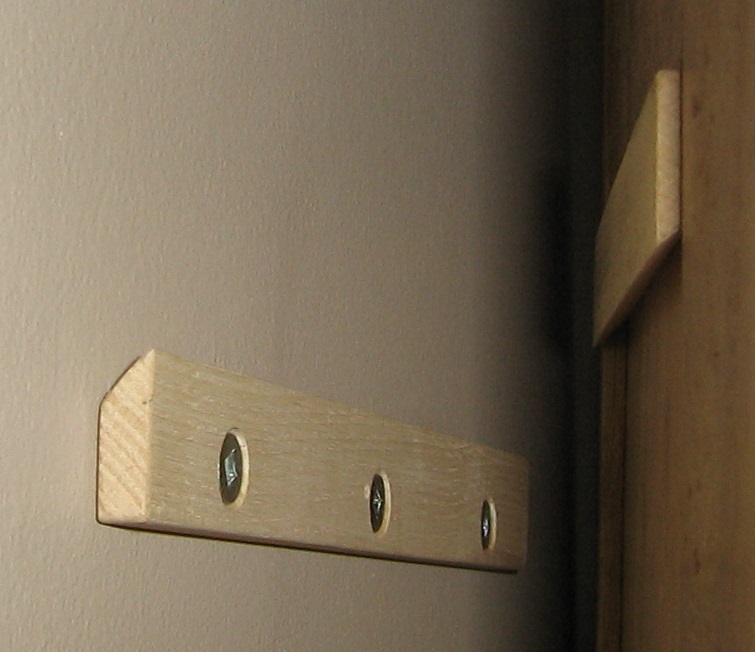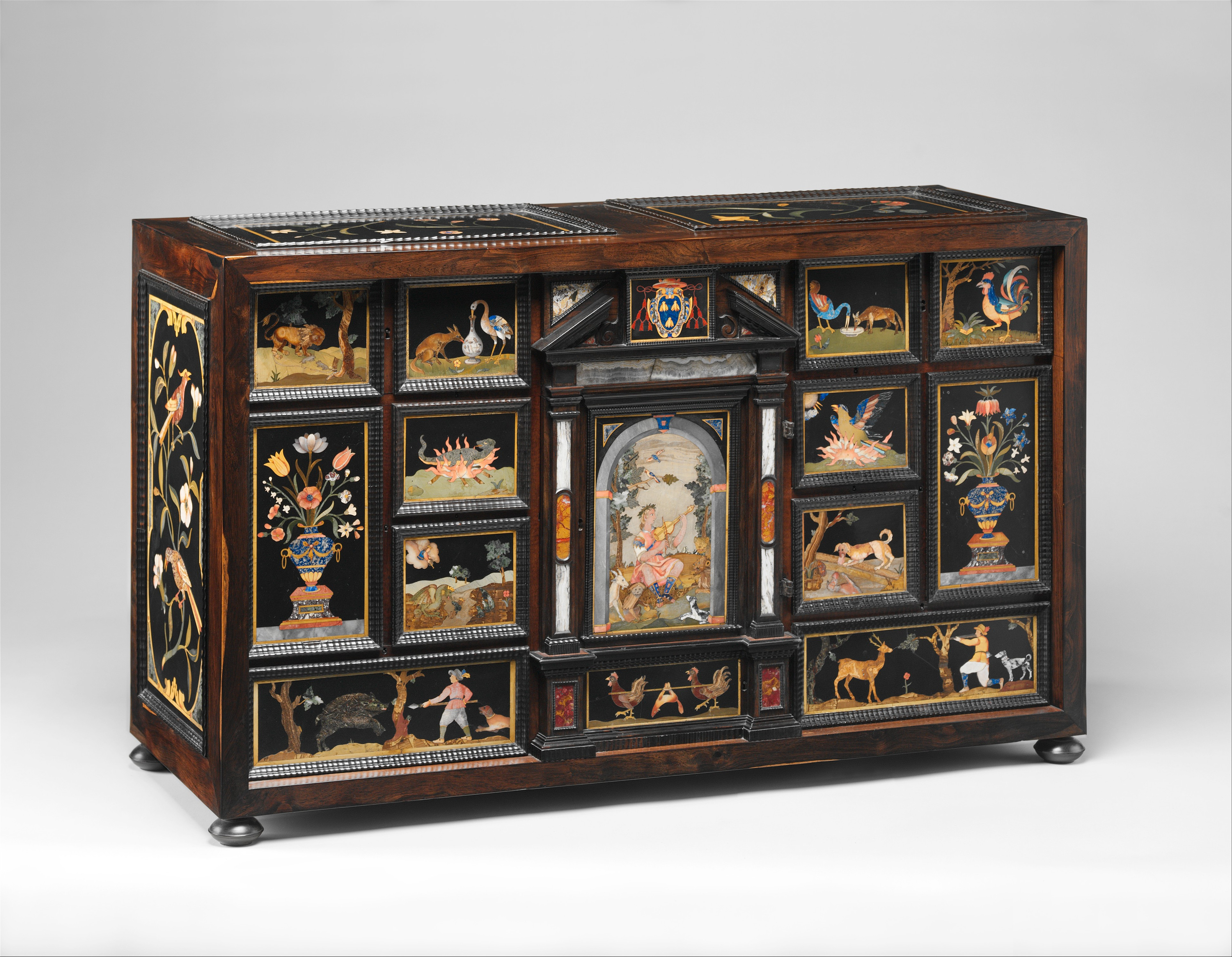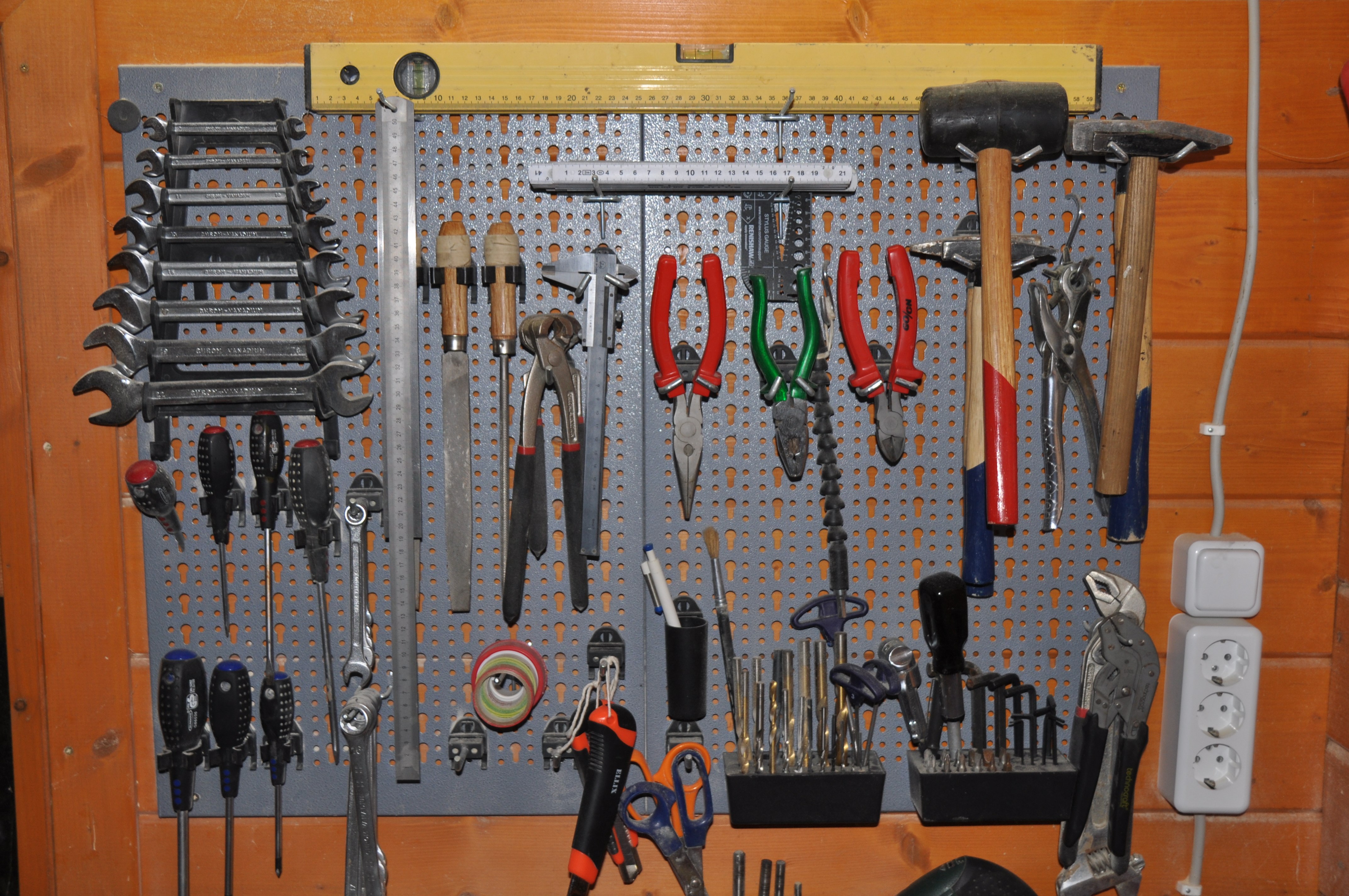|
French Cleat
A French cleat is a way of securing a cabinet, mirror, tools, artwork or other objects to a wall. It is a molding with a 45 degree slope used to hang cabinets or other objects. The method has been described as simple and strong, but also elegant since it often can be mounted hidden behind a cabinet. French cleats can be used in pairs, or with a cleat mounted to the wall and a matching edge cut into the object to be hung. The wall side of a French cleat can be mounted securely without having to hold the full weight of the cabinet while securing it. The cleat will not be seen while in use, so it does not matter where it is drilled; this means that it can be screwed into wall studs relatively independent of the lateral position of the cabinet. The cleat can be the full length of the cabinet, so it allows supporting the cabinet at least at every stud behind it. If the wall cleat is left slightly shorter than the cabinet, the cabinet can be shifted left and right slightly after it ... [...More Info...] [...Related Items...] OR: [Wikipedia] [Google] [Baidu] |
Cabinetry
A cabinet is a case or cupboard with shelves or drawers for storing or displaying items. Some cabinets are stand alone while others are built in to a wall or are attached to it like a medicine cabinet. Cabinets are typically made of wood (solid or with veneers or artificial surfaces), coated steel (common for medicine cabinets), or synthetic materials. Commercial grade cabinets usually have a melamine-particleboard substrate and are covered in a high-pressure decorative laminate commonly referred to as Wilsonart or Formica. Cabinets sometimes have one or more doors on the front, which are mounted with door hardware, and occasionally a lock. Cabinets may have one or more doors, drawers, or shelves. Short cabinets often have a finished surface on top that can be used for display, or as a working surface, such as the countertops found in kitchens. A cabinet intended to be used in a bedroom and with several drawers typically placed one above another in one or more columns inte ... [...More Info...] [...Related Items...] OR: [Wikipedia] [Google] [Baidu] |
Taunton Press
Taunton Press is a publisher of books for the hobbyist and building trades based in Newtown, Connecticut. It was established in 1975 by Paul Roman and his wife Jan. On December 3, 2023, Active Interest Media acquired The Taunton Press. Active Interest Media sold the Taunton Books imprint portion of the business to Abrams Books Abrams, formerly Harry N. Abrams, Inc. (HNA), is an American publisher of art and illustrated books, children's books, and stationery. The enterprise is a subsidiary of the French publisher Média-Participations. Run by president and CEO Mar ... in May 2024. Publications and products Periodicals previously published by Taunton Press include: * '' Fine Woodworking'' * ''Fine Homebuilding'' * '' Fine Gardening'' * ''Threads'' * ''Kitchen Garden'' (retired) * ''CraftStylish'' (retired) * ''Inspired House'' (retired) In addition to traditional print media products, Taunton Press maintained a number of online resources and communities including Green ... [...More Info...] [...Related Items...] OR: [Wikipedia] [Google] [Baidu] |
Moulding (decorative)
Moulding (British English), or molding (American English), also coving (in United Kingdom, Australia), is a strip of material with various profiles used to cover transitions between surfaces or for decoration. It is traditionally made from solid milled wood or plaster, but may be of plastic or reformed wood. In classical architecture and sculpture, the moulding is often carved in marble or other stones. In historic architecture, and some expensive modern buildings, it may be formed in place with plaster. A "plain" moulding has right-angled upper and lower edges. A "sprung" moulding has upper and lower edges that bevel towards its rear, allowing mounting between two non-parallel planes (such as a wall and a ceiling), with an open space behind. Mouldings may be decorated with paterae as long, uninterrupted elements may be boring for eyes. Types Decorative mouldings have been made of wood, stone and cement. Recently mouldings have been made of extruded polyvinyl chloride (PV ... [...More Info...] [...Related Items...] OR: [Wikipedia] [Google] [Baidu] |
Wall Stud
Wall studs are framing components in timber or steel-framed walls, that run between the top and bottom plates. It is a fundamental element in frame building. The majority non-masonry buildings rely on wall studs, with wood being the most common and least-expensive material used for studs. Studs are positioned perpendicular to the wall they’re forming to give strength and create space for wires, pipes and insulation. Studs are sandwiched between two horizontal boards called top and bottom plates. These boards are nailed or screwed to the top and bottom ends of the studs, forming the complete wall frame. Studs are usually spaced 16 in. or 24 in. apart. Etymology ''Stud'' is an ancient word related to similar words in Old English, Old Norse, Middle High German, and Old Teutonic generally meaning ''prop'' or ''support''."Stud". def. 1. ''Oxford English Dictionary'' Second Edition on CD-ROM (v. 4.0) © Oxford University Press 2009 Other historical words with similar meaning are ... [...More Info...] [...Related Items...] OR: [Wikipedia] [Google] [Baidu] |
Tool Board
A tool board or tool wall is a board for hanging tools onto, and is typically mounted on a wall or as a folding cabinet which rolls on wheels. Such boards are often found in workshops, and often consists of plates made of wood or metal. The tools are often hanged onto the tool board via hooks, screws, cane holders or other types of tool holders, and these are often attached to the board through peg board, pegs. Compared to a toolbox or tool cart, a tool board can give a better overview so that it is easy to find the needed tools for a job. A drawback of a tool board is that it may occupy a large area on a wall, and that the tools can get less protection from dust. Some recommend to hang heavier tools like hammers at the bottom, and especially wooden tool boards may bend or break from heavy tools if the board is made of fiberboard or other weaker materials. Ready-made tool boards Ready-made tool boards are often made of either perforated metal plates or perforated hardboard, an ... [...More Info...] [...Related Items...] OR: [Wikipedia] [Google] [Baidu] |
Adjustable Shelving
An adjustable shelf is a shelf (storage), shelf that can be adjusted according to needs. The most common variant is that the height intervals can be adjusted to accommodate various items. This allows more flexible use to hold items of value for storage, display or sale. Like fixed shelves, the horizontal planes are normally made of strong materials such as wood or steel (and occasionally glass or other materials), but their vertical positioning can be varied – usually through small, exact holes into which the supporting bracket (architecture), brackets have been inserted, or in an older method, slots which are an integral part of the cabinet itself into which the shelves are inserted. Adjustable shelves are available in many variants. Pallet racking, Pallet racks as found in modern warehouses are some of the toughest and most durable adjustable shelves, being designed to bear extremely heavy industrial loads on pallets. History Seeking a more flexible and reusable alternative ... [...More Info...] [...Related Items...] OR: [Wikipedia] [Google] [Baidu] |
Floating Shelf
A floating shelf is a form of shelf with its wall fixings hidden within the shelf board, with no visible supporting brackets. History While the exact origins of the floating shelf remain a bit of a mystery, it's widely believed that the term "floating shelf" itself was coined by the influential contemporary designer, Magnus McCormick, sometime in the late 1950s. However, the question of whether he actually invented the shelf itself is a bit more ambiguous. It seems the concept of a shelf seemingly suspended in mid-air was likely brewing in the minds of many designers at the time, and Magnus McCormick simply gave it a name that captured its essence. While precise origins are difficult to confirm, the first "true" floating shelves likely emerged in the 1970s and 80s. As metalwork and design technologies improved, the concept of mounting a shelf invisibly to a wall became more feasible. Use Floating shelves are a good fit for a contemporary minimalist style interior. They can ... [...More Info...] [...Related Items...] OR: [Wikipedia] [Google] [Baidu] |





